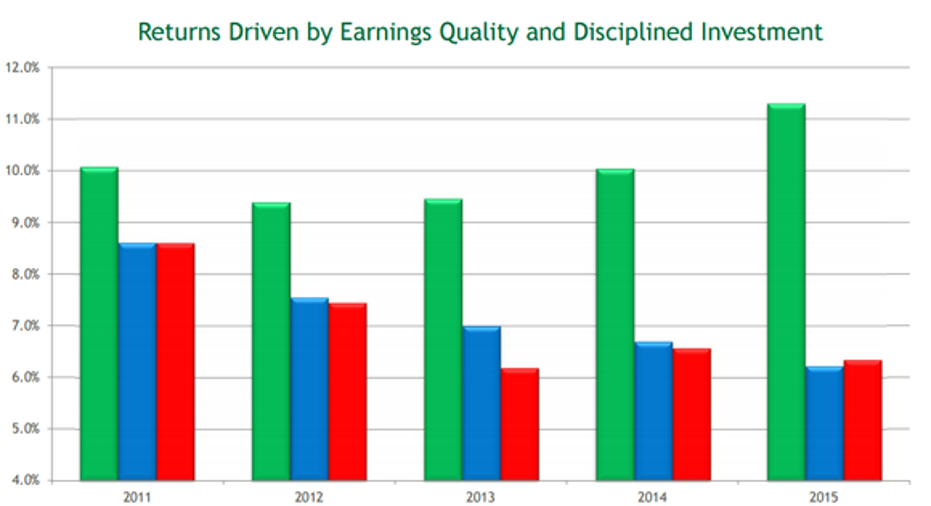4 Charts That Explain Waste Management Stock

Image source: Waste Management corporate website.
Just about everyone's portfolio has the following types of stocks: the high-flyer you didn't see coming, the complete tank job for which you had high hopes, the rock stars and the fallen stars that keep you up at night, and slow-moving stocks that keep growing modestly with little to no fanfare. Waste Management is pretty much the poster child of that last type of stock.
It's never going to wow you by doubling in a month, or even in a couple of years. Slowly and steadily, though, the company has grown by generating high returns, and giving those returns back to shareholders with dividends and share repurchases. Here are three charts that show how Waste Management does it.
By the numbersWaste handling isn't exactly the easiest business to get into. First, there's the large amount of capital expenditures to build out the infrastructure to handle that refuse, and that involves the extremely difficult process of getting a new landfill up and running. Also, with municipal waste volumes remaining flat for the past 10 years, there aren't a lot of new markets to serve, and new companies have to take on well-established businesses like Waste Management and Republic Services .
When you see the size and scope of Waste Management's operations, it's easy to see why there aren't many companies rushing in to take it on for the top spot in the industry.
Image Source: Waste Management investor presentation.
What also makes Waste Management unique is that it has found very inventive ways to turn what was previously a major cost into a competitive advantage. As the graphic above shows, the company has installed 136 landfill gas-to-energy facilities at its landfills.
These facilities take the methane emissions from decomposing garbage in landfills -- something that formerly needed to be treated and was costly -- and then converts them to a usable fuel. Many of the company's waste-handling vehicles now run on that same landfill gas, drastically reducing what was once one of Waste Management's largest costs -- fuel for its fleet.
With more than 21 million customers -- none of whom are more than 1% of total revenue -- there's plenty of waste to keep the company's collection services busy. When you add in Waste Management's inventive cost-savings mechanisms, the advantages it has over any competition seem nearly insurmountable.
Not just spending for spending's sakeThe idea that Waste Management would go to such great lengths to cut costs and give a more environmentally friendly image might at first sound like a way for the company to greenwash what is a relatively dirty job -- until you see how these spending efforts have produced the best returns in the business.
Image Source: Waste Management investor presentation.
This is a critical factor when it comes to the waste-handling industry. Companies in the space need to consistently spend capital on new fleet vehicles, or opening new landfills, once others meet their maximum capacity. In this case, Waste Management has been pulling away from its two largest competitors -- Republic Services and Waste Connections -- for the past five years. There's no guarantee that Waste Management can continue to outpace its peers like this, but the company has a long history of making solid capital-allocation decisions that have led to strong returns.
Fuel for shareholder returnsLet's face it... trash isn't the next hot industry, and that's why investors shouldn't expect Waste Management to be a rock-star stock. The company is going to slowly and steadily enhance shareholder value by translating those returns on invested capital into dividends and share repurchases that increase the value of each remaining share. During the past 15 years, Waste Management has done a good job of delivering annual dividend increases while reducing the overall share count to increase earnings and cash flow per share.
WM Dividend data by YCharts.
These two elements can combine to be a very powerful force in generating shareholder value. All you need to do is compare the total return price (share price appreciation plus reinvested dividends) of Waste Management to the S&P 500.
WM Total Return Price data by YCharts.
Now, there's no guarantee that Waste Management will be able to maintain these kinds of market-beating returns, but it certainly seems to be on the right track with the way it's delivered so far.
What a Fool believesWaste Management is one of those companies that can easily be overlooked. I mean, how often does your "aha" moment in investing come when you say "TRASH!"
Over the years, though, the company has built an infrastructure to handle America's waste that is second to none, and has invested wisely in that infrastructure to generate strong returns for investors over time. If your portfolio needs that slow-and-steady investment that you don't need to check up on all the time, then hopefully these four charts will tell you what you need to know about Waste Management, and why it could be a great stock for you.
The article 4 Charts That Explain Waste Management Stock originally appeared on Fool.com.
Tyler Crowe owns shares of Waste Management.You can follow him at Fool.comor on Twitter@TylerCroweFool.The Motley Fool owns shares of Waste Management. The Motley Fool recommends Republic Services. Try any of our Foolish newsletter services free for 30 days. We Fools may not all hold the same opinions, but we all believe that considering a diverse range of insights makes us better investors. The Motley Fool has a disclosure policy.
Copyright 1995 - 2016 The Motley Fool, LLC. All rights reserved. The Motley Fool has a disclosure policy.